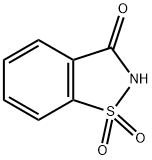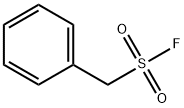Saccharin sodium dihydrate
Synonym(s):Saccharin sodium salt hydrate;Saccharin sodium dihydrate;Saccharin soluble;o-Sulfobenzimide sodium salt;2,3-Dihydro-3-oxobenzisosulfonazole sodium salt
- CAS NO.:6155-57-3
- Empirical Formula: C7H8NNaO4S
- Molecular Weight: 225.19
- MDL number: MFCD00151213
- EINECS: 612-173-5
- SAFETY DATA SHEET (SDS)
- Update Date: 2025-12-17 09:49:21

What is Saccharin sodium dihydrate?
Description
Saccharin sodium dihydrate is the sodium dihydrate form of saccharin, which belongs to the family of aromatic homomonocyclic compounds. It is an artificial sweetener that is hundreds times as sweet as sucrose. It is mainly used as a food additive to sweeten many products such as drinks, candies, cookies, and medicine. Saccharin is relatively safe for human beings without providing food energy and any nutritional value. It is also safe for diabetes patients to consume.
Chemical properties
Saccharin sodium occurs as a white, odorless or faintly aromatic, efflorescent, crystalline powder. It has an intensely sweet taste, with a metallic or bitter aftertaste that at normal levels of use can be detected by approximately 25% of the population. The aftertaste can be masked by blending saccharin sodium with other sweeteners. Saccharin sodium can contain variable amounts of water.
The Uses of Saccharin sodium dihydrate
Saccharin Sodium Salt Dihydrate is a non-nutritive sweetener; pharmaceutic aid (flavor).
Production Methods
Saccharin is produced by the oxidation of o-toluene sulfonamide by potassium permanganate in a solution of sodium hydroxide. Acidification of the solution precipitates saccharin, which is then dissolved in water at 50℃ and neutralized by addition of sodium hydroxide. Rapid cooling of the solution initiates crystallization of saccharin sodium from the liquors.
brand name
Sucaryl (Ross).
Pharmaceutical Applications
Saccharin sodium is an intense sweetening agent used in beverages,
food products, table-top sweeteners, and pharmaceutical formulations
such as tablets, powders, medicated confectionery, gels,
suspensions, liquids, and mouthwashes. It is also used
in vitamin preparations.
Saccharin sodium is considerably more soluble in water than
saccharin, and is more frequently used in pharmaceutical formulations.
Its sweetening power is approximately 300–600 times that of
sucrose. Saccharin sodium enhances flavor systems and may be used
to mask some unpleasant taste characteristics.
Injection of saccharin sodium has been used to measure the armto-
tongue circulation time.
Safety
There has been considerable controversy concerning the safety of
saccharin and saccharin sodium in recent years; however, it is now generally regarded as a safe, intense sweetener. See Saccharin for
further information.
The WHO has set a temporary acceptable daily intake of up to
2.5 mg/kg body-weight for saccharin, including its salts.(3) In the
UK, the Committee on Toxicity of Chemicals in Food, Consumer
Products, and the Environment (COT) has set an acceptable daily
intake for saccharin and its salts (expressed as saccharin sodium) at
up to 5 mg/kg body-weight.
LD50 (mouse, oral): 17.5 g/kg
LD50 (rat, IP): 7.1 g/kg
LD50 (rat, oral): 14.2 g/kg
Storage
Saccharin sodium is stable under the normal range of conditions
employed in formulations. Only when it is exposed to a high
temperature (125℃) at a low pH (pH 2) for over 1 hour does
significant decomposition occur. The 84% grade is the most stable
form of saccharin sodium since the 76% form will dry further under
ambient conditions. Solutions for injection can be sterilized by
autoclave.
Saccharin sodium should be stored in a well-closed container in a
dry place.
Incompatibilities
Saccharin sodium does not undergo Maillard browning.
Regulatory Status
Accepted for use as a food additive in Europe; ‘E954’ is applied to both saccharin and saccharin salts. Included in the FDA Inactive Ingredients Database (buccal and dental preparations; IM and IV injections; oral and topical preparations). Included in nonparenteral medicines licensed in the UK. Included in the Canadian List of Acceptable Non-medicinal Ingredients.
References
https://en.wikipedia.org/wiki/Saccharin
https://pubchem.ncbi.nlm.nih.gov/compound/saccharin#section=Top
Properties of Saccharin sodium dihydrate
| Melting point: | > 300℃ |
| Flash point: | >200°C |
| storage temp. | 2-8°C |
| solubility | 1000g/l |
| form | powder to crystaline |
| color | White to Almost white |
| PH | 6.0-7.5 (100g/l, H2O, 20℃) |
| Water Solubility | Soluble in water. Slightly soluble in alcohol |
| Merck | 14,8311 |
| InChI | InChI=1S/C7H5NO3S.Na.H2O.H/c9-7-5-3-1-2-4-6(5)12(10,11)8-7;;;/h1-4H,(H,8,9);;1H2; |
| CAS DataBase Reference | 6155-57-3(CAS DataBase Reference) |
Safety information for Saccharin sodium dihydrate
Computed Descriptors for Saccharin sodium dihydrate
| InChIKey | BCWVKFPXENUOQA-UHFFFAOYSA-N |
| SMILES | O=S1(NC(=O)C2C=CC=CC1=2)=O.[NaH].O |
Saccharin sodium dihydrate manufacturer
Clickchem Research LLP
New Products
Indole Methyl Resin tert-butyl 9-methoxy-3-azaspiro[5.5]undecane-3-carboxylate Boc-His(Boc)-OH 2-CTC Resin 4-Chloro-7-tosy1-7Hpyrrolo[2,3-d]pyrimidine 5,7-Dibromo-1H-indole 2,5-dichloro-N-hydroxy-4,6-dimethylpyridine-3-carboximidamide 2,2-Dimethoxy-7-azaspiro[3.5]nonane hydrochloride 4-chloromethyl-5-methyl-1,3-dioxol-2-one (DMDO-Cl) R-2-BENZYLOXY PROPIONIC ACID 1,1’-CARBONYLDIIMIDAZOLE 1,1’-CARBONYLDI (1,2-4 TRIAZOLE) N-METHYL INDAZOLE-3-CARBOXYLIC ACID 4-((2-hydroxyethyl)thio)benzoic acid 1-(TERT-BUTOXYCARBONYL)-2-PYRROLIDINONE Methyl 6-methylnicotinate 3-Pyridineacrylic acid tert-Butyl carbazate TETRAHYDRO-2H-PYRAN-3-OL 2-((4-morpholinophenylamino) (methylthio) methylene) malononitrile 3-(4-morpholinophenylamino)-5-amino-1H-pyrazole-4-carbonitrile 2,4-dihydroxybenzaldehyde 1,3-Diethyl-1,3-Diphenylurea Methyl 2-methylquinoline-6-carboxylateRelated products of tetrahydrofuran








You may like
-
 Saccharin Sodium Dihydrate CAS 6155-57-3View Details
Saccharin Sodium Dihydrate CAS 6155-57-3View Details
6155-57-3 -
 Saccharin sodium dihydrate 98% (HPLC) CAS 6155-57-3View Details
Saccharin sodium dihydrate 98% (HPLC) CAS 6155-57-3View Details
6155-57-3 -
 o-Sulfobenzimide Sodium Salt Dihydrate CAS 6155-57-3View Details
o-Sulfobenzimide Sodium Salt Dihydrate CAS 6155-57-3View Details
6155-57-3 -
 Saccharin sodium salt dihydrate CAS 6155-57-3View Details
Saccharin sodium salt dihydrate CAS 6155-57-3View Details
6155-57-3 -
 Saccharin sodium salt dihydrate CAS 6155-57-3View Details
Saccharin sodium salt dihydrate CAS 6155-57-3View Details
6155-57-3 -
 Sodium SaccharinView Details
Sodium SaccharinView Details
128-44-9 -
 Purity: 99.9% Sodium Saccharin Chemical GranulesView Details
Purity: 99.9% Sodium Saccharin Chemical GranulesView Details
128-44-9 -
 99% Sodium Saccharin Powder, For Food / Pharma, 25 KgsView Details
99% Sodium Saccharin Powder, For Food / Pharma, 25 KgsView Details
6155-57-3
